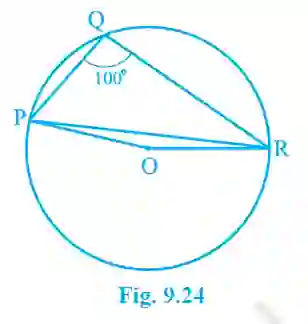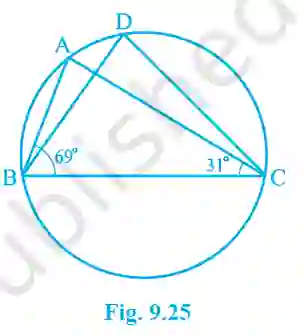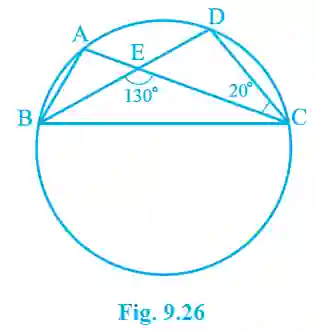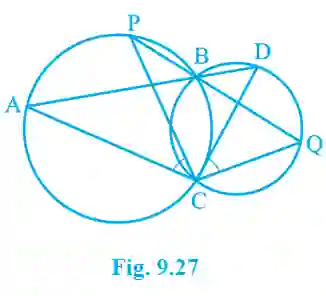Exercise 9.3 Solutions (Class 9)
Circles
1. In Fig. 9.23, A, B and C are three points on a circle with centre O such that ∠BOC = 30° and ∠AOB = 60°. If D is a point on the circle other than the arc ABC, find ∠ADC.
 >
>We have ∠AOC = ∠AOB + ∠BOC = 60° + 30° = 90°.
We know that the angle subtended by an arc at the centre is double the angle subtended by it at any point on the remaining part of the circle.
∠ADC = (1/2) × ∠AOC = (1/2) × 90° = 45°.
Answer: ∠ADC = 45°.
2. A chord of a circle is equal to the radius of the circle. Find the angle subtended by the chord at a point on the minor arc and also at a point on the major arc.
Let AB be a chord of a circle with centre O and radius r. Given AB = OA = OB = r.
Therefore, ΔOAB is an equilateral triangle.
The angle subtended by the chord at the centre is ∠AOB = 60°.
Let C be a point on the major arc. The angle subtended at the major arc is:
∠ACB = (1/2) × ∠AOB = (1/2) × 60° = 30°.
Let D be a point on the minor arc. The angle subtended at the minor arc is found using the property of cyclic quadrilaterals (ADBC).
The sum of opposite angles of a cyclic quadrilateral is 180°.
∠ADB + ∠ACB = 180° => ∠ADB + 30° = 180° => ∠ADB = 150°.
Answer: The angle on the major arc is 30° and on the minor arc is 150°.
3. In Fig. 9.24, ∠PQR = 100°, where P, Q and R are points on a circle with centre O. Find ∠OPR.
 >
>The angle subtended by arc PR at the centre is the reflex angle ∠POR.
Reflex ∠POR = 2 × ∠PQR = 2 × 100° = 200°.
The other angle at the centre is ∠POR = 360° – 200° = 160°.
Now consider the isosceles triangle ΔOPR, where OP = OR (radii).
Therefore, ∠OPR = ∠ORP.
In ΔOPR, ∠OPR + ∠ORP + ∠POR = 180°.
2∠OPR + 160° = 180° => 2∠OPR = 20° => ∠OPR = 10°.
Answer: ∠OPR = 10°.
4. In Fig. 9.25, ∠ABC = 69°, ∠ACB = 31°, find ∠BDC.
 >
>In ΔABC, by Angle Sum Property:
∠BAC + ∠ABC + ∠ACB = 180°
∠BAC + 69° + 31° = 180° => ∠BAC = 180° – 100° = 80°.
Angles in the same segment of a circle are equal.
∠BDC and ∠BAC are angles in the same segment subtended by the chord BC.
Therefore, ∠BDC = ∠BAC = 80°.
Answer: ∠BDC = 80°.
5. In Fig. 9.26, A, B, C and D are four points on a circle. AC and BD intersect at a point E such that ∠BEC = 130° and ∠ECD = 20°. Find ∠BAC.
 >
>In ΔDEC, the exterior angle ∠BEC is equal to the sum of the interior opposite angles, ∠EDC + ∠ECD.
130° = ∠EDC + 20° => ∠EDC = 110°.
Since ∠EDC and ∠BDC are the same, ∠BDC = 110°.
Angles in the same segment are equal. ∠BAC and ∠BDC are subtended by the same arc BC. Wait, this is wrong. Let’s use another method.
In the straight line BD, ∠DEC + ∠BEC = 180°.
∠DEC = 180° – 130° = 50°.
In ΔDEC, by Angle Sum Property:
∠EDC + ∠DCE + ∠DEC = 180°
∠EDC + 20° + 50° = 180° => ∠EDC = 110°.
Since ∠BDC = ∠EDC, we have ∠BDC = 110°.
Now, ∠BAC and ∠BDC are angles in the same segment, subtended by chord BC. Therefore, ∠BAC = ∠BDC = 110°.
Answer: ∠BAC = 110°.
6. ABCD is a cyclic quadrilateral whose diagonals intersect at a point E. If ∠DBC = 70°, ∠BAC = 30°, find ∠BCD. Further, if AB = BC, find ∠ECD.
Step 1: Find ∠BDC.
∠BDC = ∠BAC (Angles in the same segment). So, ∠BDC = 30°.
Step 2: Find ∠BCD.
In ΔBCD, the sum of angles is 180°.
∠BCD + ∠DBC + ∠BDC = 180°
∠BCD + 70° + 30° = 180° => ∠BCD = 180° – 100° = 80°.
Step 3: Find ∠ECD if AB = BC.
In ΔABC, since AB = BC, it is an isosceles triangle.
So, ∠BCA = ∠BAC = 30°.
Now, ∠ECD = ∠BCD – ∠BCA = 80° – 30° = 50°.
Answer: ∠BCD = 80° and ∠ECD = 50°.
7. If diagonals of a cyclic quadrilateral are diameters of the circle through the vertices of the quadrilateral, prove that it is a rectangle.
Given: ABCD is a cyclic quadrilateral. Diagonals AC and BD are diameters of the circle.
To Prove: ABCD is a rectangle.
Proof:
Since AC is a diameter, the angle subtended by it in the semicircle is a right angle.
Therefore, ∠ABC = 90° and ∠ADC = 90°.
Similarly, since BD is a diameter, the angle subtended by it in the semicircle is a right angle. Therefore, ∠BAD = 90° and ∠BCD = 90°.
Since all four angles of the quadrilateral ABCD are 90°, it is a rectangle.
Hence, proved.
8. If the non-parallel sides of a trapezium are equal, prove that it is cyclic.
Given: Trapezium ABCD with AB || DC and non-parallel sides AD = BC.
To Prove: ABCD is a cyclic quadrilateral.
Construction: Draw perpendiculars DM and CN from D and C to the side AB.
Proof:
In right triangles ΔDMA and ΔCNB:
• AD = BC (Given)
• DM = CN (Distance between parallel lines is constant)
By RHS congruence rule, ΔDMA ≅ ΔCNB.
So, ∠A = ∠B (by CPCT).
We also know that for parallel lines AB and DC, ∠A + ∠D = 180° and ∠B + ∠C = 180° (consecutive interior angles).
Since ∠A = ∠B, it follows that ∠A + ∠C = 180° (substituting ∠B with ∠A in the second sum).
A quadrilateral is cyclic if the sum of a pair of opposite angles is 180°. Since ∠A + ∠C = 180°, the trapezium ABCD is cyclic.
Hence, proved.
9. Two circles intersect at two points B and C. Through B, two line segments ABD and PBQ are drawn to intersect the circles at A, D and P, Q respectively. Prove that ∠ACP = ∠QCD.
 >
>For the first circle, angles subtended by the same arc AP are equal.
So, ∠ACP = ∠ABP. —(1)
For the second circle, angles subtended by the same arc DQ are equal.
So, ∠QCD = ∠QBD. —(2)
∠ABP and ∠QBD are vertically opposite angles formed by the intersection of lines AD and PQ.
Therefore, ∠ABP = ∠QBD. —(3)
From equations (1), (2), and (3), we can conclude:
∠ACP = ∠QCD.
Hence, proved.
10. If circles are drawn taking two sides of a triangle as diameters, prove that the point of intersection of these circles lie on the third side.
Given: ΔABC. Circles are drawn with sides AB and AC as diameters. Let these circles intersect at points A and D.
To Prove: Point D lies on the third side BC.
Construction: Join AD.
Proof:
For the circle with diameter AB, the angle in the semicircle is a right angle. So, ∠ADB = 90°.
For the circle with diameter AC, the angle in the semicircle is a right angle. So, ∠ADC = 90°.
Now, add these two angles: ∠ADB + ∠ADC = 90° + 90° = 180°.
Since the sum of these adjacent angles is 180°, BDC must be a straight line.
This means that the point D lies on the side BC.
Hence, proved.
11. ABC and ADC are two right triangles with common hypotenuse AC. Prove that ∠CAD = ∠CBD.
Given: ΔABC and ΔADC are right-angled at B and D respectively, with common hypotenuse AC.
To Prove: ∠CAD = ∠CBD.
Proof:
Consider a circle drawn with the common hypotenuse AC as the diameter.
Since ∠ABC = 90° and ∠ADC = 90°, both points B and D must lie on this circle (as the angle in a semicircle is a right angle).
This means that the points A, B, C, and D are concyclic (they lie on the same circle).
Now consider the chord CD. The angles subtended by this chord in the same segment are ∠CAD and ∠CBD.
Since angles in the same segment of a circle are equal, we have ∠CAD = ∠CBD.
Hence, proved.
12. Prove that a cyclic parallelogram is a rectangle.
Given: ABCD is a cyclic parallelogram.
To Prove: ABCD is a rectangle.
Proof:
Since ABCD is a parallelogram, opposite angles are equal.
So, ∠A = ∠C and ∠B = ∠D. —(1)
Since ABCD is a cyclic quadrilateral, the sum of opposite angles is 180°. So, ∠A + ∠C = 180° and ∠B + ∠D = 180°. —(2)
Using equations (1) and (2):
∠A + ∠A = 180° => 2∠A = 180° => ∠A = 90°.
A parallelogram with one angle equal to 90° is a rectangle.
(Since if ∠A=90°, then ∠C=90°, and consecutive angles ∠B and ∠D must also be 90°).
Hence, proved.



